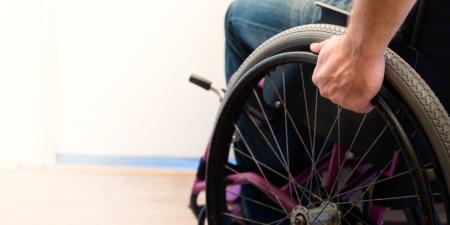If we are to understand the current relationship between the disability community and the medical community, we must turn to history. People with disabilities have long faced discrimination, some of it at the hands of medical professionals.
In the United States, as part of the eugenics movement, forced sterilization of those with disabilities was ruled constitutional by the US Supreme Court in 1927 in Buck vs. Bell and remained legal in some states until 2003 [1]. Eugenic efforts in the United States would eventually be used as models for the radical application of eugenic ideas in Nazi Germany [2], which sterilized and euthanized persons with disabilities.
Another well-known major act of discrimination against people with disabilities was their widespread institutionalization. From the mid-nineteenth century until the 1960s, it was normal practice to isolate and segregate individuals with disabilities in institutions [3], which became infamous for mistreating those in their care [4].
At the same time, medicine has also made essential advances in the treatment of individuals with disabilities. In some cases, medicine has even greatly extended the lifespan of people with disabilities. For example, the average lifespan of individuals with Down syndrome has risen from around 25 years in the 1980s to 60 today, due to multiple medical advances, including advances in open-heart surgery for congenital heart defects [5].
Despite medical advances in the care of individuals with disabilities, tensions between the disability community and the medical community remain. Ultimately, one could argue that it is the medical community—by distinguishing “normal” from “abnormal”—that sets the foundation for broader social and cultural expressions of discrimination against people with disabilities. For this reason, the medical community has been accused of assigning lesser value to the lives of those with disabilities [6, 7].
Tensions between the disability and medical communities can be better understood by examining differences between the medical and social models of disability. The medical model of disability, which is still largely accepted in the medical community, views disability as a pathology and thus as something to be treated or cured. Rather than viewing disability as a problem to be solved, the social model views disability as diversity to be valued. The social model of disability suggests that disability is largely socially situated or constructed, rather than caused by the individual’s attributes [8]. This model separates impairment from disability; the term “impairment” is used to describe the body, such as the lack of a limb or the dysfunction of a particular organ or system, and the term “disability” to refer to the disadvantage caused by social structures rather than the impairment itself [9].
As both a medical student and family member of a person with Down syndrome, I have personal experience with the tensions between the two communities. As a medical student, I have spent hours studying and memorizing the “pathologies” affiliated with disability—attributes that are supposed to be problems in need of cure. As a sibling and self-described disability advocate, I value disability as diversity and can easily describe ways in which it is in fact society, not impairment, that is disabling to many people with disabilities. I am fascinated by medical advances such as cell-free fetal DNA testing but terrified by the ways in which they could be used to promote further discrimination against people with disabilities.
However, I would like to put forth the idea that the medical and disability communities actually have the potential to be exceptional allies. Medicine is poised to support people with disabilities to live the lives they desire based on their personal goals. In order for this to occur, patients with disabilities must feel as though they can discuss any physiologic challenges they face as a result of an impairment without fear of discrimination. Similarly, physicians must be able to appropriately discuss and support patients in addressing socially constructed challenges they face.
In this issue of the AMA Journal of Ethics, I have worked with many exceptional authors to address the roles of physicians in balancing the social and medical models of disability. We consider both the role medicine plays in disabling and even the smallest ways it could begin to combat this history. The history of institutionalization and eugenics are addressed in this issue. Turning to the modern era, Gareth M. Thomas and Barbara Katz Rothman examine the use of noninvasive prenatal testing and whether it promotes new eugenic practices.
Undoubtedly, unconscious bias plays a big role in discrimination against any group of people, including those with disabilities. The issue of bias when discussing reproductive health care for women with disabilities is the focus of three articles. In their case commentaries, Stephen Corey and Peter Bulova weigh the risks and benefits of performing a pap smear when the patient does not fully understand the need for the procedure, while Sonya Charles specifically examines the need to obtain assent or consent in such a case. In another case commentary, Kruti Acharya and John Lantos discuss a mother’s request for a hysterectomy for her daughter, who struggles to manage her menstrual cycles. Anita Silvers, Leslie Francis, and Brittany Badesch examine whether women with disabilities should have equal access to reproductive health services. The issue of bias in reproductive health care also arises when delivering prenatal diagnoses of disabilities. Eva Schwartz and Kishore Vellody address such issues in their case commentary, which examines how to ethically deliver a diagnosis of Down syndrome following prenatal testing and appropriate counseling if the patient requests an abortion.
Medical education may provide an avenue to address unconscious biases toward people with disabilities more broadly. Kerry Boyd describesMcMaster University’s Curriculum of Caring, which educates medical students about providing compassionate, person-centered care by incorporating the views and experiences of persons with disabilities.
Not only do many people hold unconscious bias toward individuals with disabilities, but individuals with disabilities, particularly intellectual disabilities, face numerous health care disparities; they often have difficulty finding and accessing appropriate medical care despite their high medical needs [10]. Lyubov Slashcheva, Rick Rader, and Steve Sulkes make a case for classifying people with disabilities as a medically underserved population.
People with disabilities also frequently face discrimination in the workplace. Yvonne Kellar-Guenther responds to an article by Carrie Griffin Basas, which argues that workplace wellness programs institutionalize disability bias, by sketching the ideal workplace wellness program.
The legal world also has much to offer in guiding interactions and avoiding discrimination when working with people with disabilities, the most relevant legislation being the Americans with Disabilities Act (ADA) of 1990. Another ethical question that overlaps with the legal realm is about decision-making capacity and types of decision making. Both historically and presently, persons with disabilities tend to be seen as limited in their abilities to make informed health care decisions. However, they simultaneously have the right to be involved in their care. In the podcast, Susan Mizner discusses how we can preserve their autonomy in making health care decisions. Richard Weinmeyer considers the roles health care organizations must play in preventing injuries that can lead to disability for health care professionals.
Finally, the value of disability is discussed in multiple pieces. George Estreich discusses the divides that exist between patients with disabilities and their physicians as strategies for bridging them. Janet DesGeroges provides a parent’s perspective on the conflicting pressures parents face when a child is discovered to have hearing loss. Jasmine Zahid reviewsRosemarie Garland-Thomson’s article that argues for disability as a narrative, epistemic, and ethical resource.
This issue of the AMA Journal of Ethics only begins to introduce the tensions between the disability community and the medical community. In doing so, it seeks to bring to light some of the concerns of the disability rights movement about the care of individuals with disabilities. I encourage you to continue to explore and discuss how viewing disability as either pathology or as diversity may affect the ways in which we care for our patients with disabilities and how it can influence their health.
References
-
Governor’s Task Force to Determine the Method of Compensation for Victims of North Carolina’s Eugenic Board. Final report to the governor of North Carolina: pursuant to Executive Order 83. January 2012. http://www.sterilizationvictims.nc.gov/documents/FinalReport-GovernorsEugenicsCompensationTaskForce.pdf. Accessed February 26, 2016.
- Barondess JA. Medicine against society. Lessons from the Third Reich. JAMA. 1996;276(20):1657-1661.
-
Wolfensberger W. The origin and nature of our institutional models. In: Kugel RB, Shearer A, eds. Changing Patterns in Residential Services for the Mentally Retarded. 2nd ed. Washington, DC: President’s Committee on Mental Retardation; 1976:63-171.
- Thornberry C, Olson K. The abuse of individuals with developmental disabilities. Dev Disabil Bull. 2005;33(1&2):1-19.
- Bittles AH, Glasson EJ. Clinical, social, and ethical implications of changing life expectancy in Down syndrome. Dev Med Child Neurol. 2004;46(4):282-286.
-
Asch A. Disability, bioethics, and human rights. In: Albrecht GA, Seelman KD, Bury M, eds. Handbook of Disability Studies. Thousand Oaks, CA: Sage; 2001:297-326.
- Parens E, Asch A. Disability rights critique of prenatal genetic testing: reflections and recommendations. Ment Retard Dev Disabil Res Rev. 2003;9(1):40-47.
-
Smith WT, Roth JJ, Okoro O, Kimberlin C, Odedina FT. Disability in cultural competency pharmacy training. Am J Pharm Educ. 2011:75(2):26.
- Goering S. Rethinking disability: the social model of disability and chronic disease. Curr Rev Musculoskelet Med. 2015;8(2):134-138.
- Reichard A, Sacco TM, Turnbull HR 3rd. Access to health care for individuals with developmental disabilities from minority backgrounds. Ment Retard. 2004;42(6):459-470.



